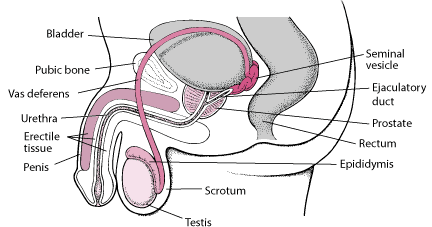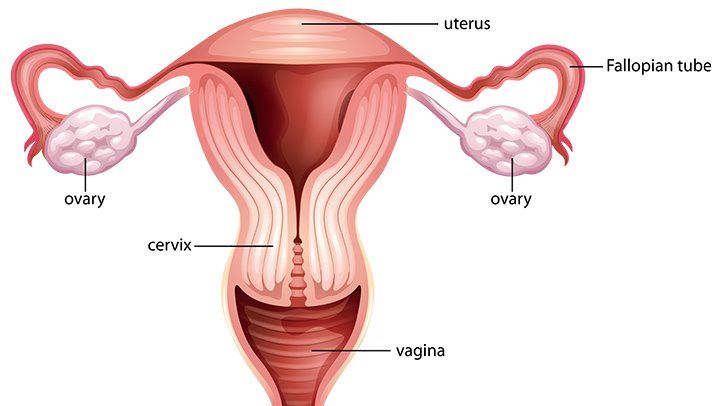Back to: BASIC SCIENCE TECHNOLOGY JSS 1
Welcome to class!
In today’s class, we will be talking about the reproductive system. Enjoy the class!
Reproductive System

What is the reproductive system?
The reproductive system is a collection of internal and external organs, in both males and females that work together to procreate and give rise to younger ones. The reproductive system in humans is most highly developed among animals. We have a female and male reproductive system. The female reproductive system includes the vagina and uterus which act as the receptacle for semen, the ovaries which produce the female ova, the vaginal is attached to the uterus through the cervix, while Fallopian tube connects the uterus to the ovaries. While the man reproductive system includes the penis, testes, sex glands, spermatic ducts, and scrotum.
Types of reproduction.
- Sexual reproduction.
- Asexual reproduction.
Sexual reproduction:
It is the combination of (usually haploid, or having a single set of unpaired chromosomes) reproductive cells from two individuals to form a third (usually diploid, or having a pair of each type of chromosome) unique offspring. Sexual reproduction produces offspring with novel combinations of genes. This can be an adaptive advantage in unstable or unpredictable environments.
As humans, we are used to thinking of animals as having two separate sexes, male and female, determined at conception. However, in the animal kingdom, there are many variations on this theme. Sexual reproduction is the process where two cells (gametes) fuse to form one fertilized cell or zygote.
In the case of an animal, the sexual reproductive is done by using the reproductive organ. The two types of reproductive organ include;
- Male reproductive organ.
- Female reproductive organ.
The male reproductive system includes;

- Penis:
This is the male organ used in sexual intercourse. It has three parts: the root, which attaches to the wall of the abdomen; the body, or shaft; and the glans, which is the cone-shaped part at the end of the penis. The glans, also called the head of the penis, is covered with a loose layer of skin called the foreskin. This skin is sometimes removed in a procedure called circumcision.
The opening of the urethra, the tube that transports semen and urine, is at the tip of the penis. The glans of the penis also contains several sensitive nerve endings. The body of the penis is cylindrical and consists of three circular shaped chambers. These chambers are made up of special, sponge-like tissue. This tissue contains thousands of large spaces that fill with blood when the man is sexually aroused.
As the penis fills with blood, it becomes rigid and erect, which allows for penetration during sexual intercourse. The skin of the penis is loose and elastic to accommodate changes in penis size during an erection.
Semen, which contains sperm (reproductive cells), is expelled (ejaculated) through the end of the penis when the man reaches sexual climax (orgasm). When the penis is erect, the flow of urine is blocked from the urethra, allowing only semen to be ejaculated at orgasm.
- Scrotum: This is the loose pouch-like sac of skin that hangs behind and below the penis. It contains the testicles (also called testes), as well as many nerves and blood vessels. The scrotum acts as a “climate control system” for the testes. For normal sperm development, the testes must be at a temperature slightly cooler than body temperature. Special muscles in the wall of the scrotum allow it to contract and relax, moving the testicles closer to the body for warmth or farther away from the body to cool the temperature.
- Testicle (testes): These are oval organs about the size of large olives that lie in the scrotum, secured at either end by a structure called the spermatic cord. Most men have two testes. The testes are responsible for making testosterone, the primary male sex hormone, and for generating sperm. Within the testes are coiled masses of tubes called seminiferous tubules. These tubes are responsible for producing sperm cells.
- Epididymis: The epididymis is a long, coiled tube that rests on the backside of each testicle. It transports and stores sperm cells that are produced in the testes. It also is the job of the epididymis to bring the sperm to maturity, since the sperm that emerge from the testes are immature and incapable of fertilization. During sexual arousal, contractions force the sperm into the vas deferens.
- Vas deferens: The vas deferens is a long, muscular tube that travels from the epididymis into the pelvic cavity, to just behind the bladder. The vas deferens transports mature sperm to the urethra, the tube that carries urine or sperm outside of the body, in preparation for ejaculation.
- Ejaculatory ducts: These are formed by the fusion of the vas deferens and the seminal vesicles (see below). The ejaculatory ducts empty into the urethra.
- urethra: The urethra is the tube that carries urine from the bladder to outside of the body. In males, it has the additional function of ejaculating semen when the man reaches orgasm. When the penis is erect during sex, the flow of urine is blocked from the urethra, allowing only semen to be ejaculated at orgasm.
- Seminal vesicles: The seminal vesicles are sac-like pouches that attach to the vas deferens near the base of the bladder. The seminal vesicles produce a sugar-rich fluid (fructose) that provides sperm with a source of energy to help them move. The fluid of the seminal vesicles makes up most of the volume of a man’s ejaculatory fluid, or ejaculate.
- Prostate gland: The prostate gland is a walnut-sized structure that is located below the urinary bladder in front of the rectum. The prostate gland contributes additional fluid to the ejaculate. Prostate fluids also help to nourish the sperm. The urethra, which carries the ejaculate to be expelled during orgasm, runs through the centre of the prostate gland.
- Bulbourethral glands: Also called Cowper’s glands, these are pea-sized structures located on the sides of the urethra just below the prostate gland. These glands produce a clear, slippery fluid that empties directly into the urethra. This fluid serves to lubricate the urethra and to neutralize any acidity that may be present due to residual drops of urine in the urethra
The female reproductive systems include the following:
- Vaginal: The vaginas a fibromuscular (made up of fibrous and muscular tissue) canal leading from the outside of the body to the cervix of the uterus or womb. It is also referred to as the birth canal in the context of pregnancy. The vagina accommodates the male penis during sexual intercourse. Semen containing spermatozoa is ejaculated from the male at orgasm, into the vagina potentially enabling fertilization of the egg cell (ovum) to take place. The vagina is a canal that joins the cervix (the lower part of the uterus) to the outside of the body. It also is known as the birth canal.
- Uterus (womb): The uterus is a hollow, pear-shaped organ that is the home to a developing fetus. The uterus is divided into two parts: the cervix, which is the lower part that opens into the vagina, and the main body of the uterus, called the corpus. The corpus can easily expand to hold a developing baby. A channel through the cervix allows sperm to enter and menstrual blood to exit.
- Ovaries: The ovaries are small, oval-shaped glands that are located on either side of the uterus. The ovaries produce eggs and hormones.
- Fallopian tubes: These are narrow tubes that are attached to the upper part of the uterus and serve as tunnels for the ova (egg cells) to travel from the ovaries to the uterus. Conception, the fertilization of an egg by a sperm, normally occurs in the Fallopian tubes. The fertilized egg then moves to the uterus, where it implants into the lining of the uterine wall.
In our next class, we will be talking more about the Reproductive System. We hope you enjoyed the class.
Should you have any further question, feel free to ask in the comment section below and trust us to respond as soon as possible.

